Three-Dimensional Subsurface Pipe Network Survey and Target Identification Using Ground-Penetrating Radar: A Case Study at Jilin Jianzhu University Campus
Abstract
1. Introduction
2. GPR Field Survey and Data Processing
2.1. Description of the Test Site in the JLJU Campus
2.2. Field Data Acquisition
3. Results
3.1. Basic Data Processing and Interpretation
- Manhole covers (square or round) and the rainwater catch basin
- Cafeteria wall and the foundation below
- Staircase
- Electrical cables (with markers)
- Mouse cavities
3.2. Three-Dimensional Imaging and Common Attribute Analysis
3.3. Time-Varying Centroid Frequency Attribute Analysis
4. Discussion
5. Conclusions
Author Contributions
Funding
Institutional Review Board Statement
Informed Consent Statement
Data Availability Statement
Acknowledgments
Conflicts of Interest
References
- Jol, H.M. Ground Penetrating Radar Theory and Applications; Elsevier: Oxford, UK, 2009. [Google Scholar]
- Grandjean, G.; Paillou, P.; Dubois-Fernandez, P.; August-Bernex, T.; Baghdadi, N.N.; Achache, J. Subsurface structures detection by combining L-band polarimetric SAR and GPR data: Example of the Pyla Dune (France). IEEE. Trans. Geosci. Remote Sens. 2001, 39, 1245–1258. [Google Scholar] [CrossRef]
- Diz-Mellado, E.; Mascort-Albea, E.J.; Romero-Hernández, R.; Galán-Marín, C.; Rivera-Gómez, C.; Ruiz-Jaramillo, J.; Jaramillo-Morilla, A. Non-destructive testing and Finite Element Method integrated procedure for heritage diagnosis: The Seville Cathedral case study. J. Build. Eng. 2021, 37, 102134. [Google Scholar] [CrossRef]
- Rucka, M.; Lachowicz, J.; Zielinska, M. GPR investigation of the strengthening system of a historic masonry tower. J. Appl. Geophys. 2016, 131, 94–102. [Google Scholar] [CrossRef]
- Orlando, L. Detecting steel rods and micro-piles: A case history in a civil engineering application. J. Appl. Geophys. 2012, 81, 130–138. [Google Scholar] [CrossRef]
- Negri, S.; Aiello, M.A. High-resolution GPR survey for masonry wall diagnostics. J. Build. Eng. 2021, 33, 101817. [Google Scholar] [CrossRef]
- Rasol, M.A.; Pérez-Gracia, V.; Fernandes, F.M.; Pais, J.C.; Santos-Assunçao, S.; Santos, C.; Sossa, V. GPR laboratory tests and numerical models to characterize cracks in cement concrete specimens, exemplifying damage in rigid pavement. Measurement 2020, 158, 107662. [Google Scholar] [CrossRef]
- Khamzin, A.K.; Varnavina, A.V.; Torgashov, E.V.; Anderson, N.L.; Sneed, L.H. Utilization of air-launched ground penetrating radar (GPR) for pavement condition assessment. Constr. Build. Mater. 2017, 141, 130–139. [Google Scholar] [CrossRef]
- Zhang, X.; Pei, J.; Sha, X.; Feng, X.; Hu, X.; Chen, C.; Song, Z. Experimental Co-Polarimetric GPR Survey on Artificial Vertical Concrete Cracks by the Improved Time-Varying Centroid Frequency Scheme. Remote Sens. 2024, 16, 2095. [Google Scholar] [CrossRef]
- Saarenketo, T.; Scullion, T. Road evaluation with ground penetrating radar. J. Appl. Geophys. 2000, 43, 119–138. [Google Scholar] [CrossRef]
- He, R.; Nantung, T.; Olek, J.; Lu, N. Field study of the dielectric constant of concrete: A parameter less sensitive to environmental variations than electrical resistivity. J. Build. Eng. 2023, 74, 106938. [Google Scholar] [CrossRef]
- Xie, L.Y.; Xia, Z.H.; Xue, S.T.; Fu, X.L. Detection of setting time during cement hydration using ground penetrating radar. J. Build. Eng. 2022, 60, 105166. [Google Scholar] [CrossRef]
- Grasmueck, M.; Weger, R.; Horstmeyer, H. Full-resolution 3D GPR imaging. Geophysics 2005, 70, K12–K19. [Google Scholar] [CrossRef]
- Yaramanci, U.; Lange, G.; Hertrich, M. Aquifer characterisation using Surface NMR jointly with other geophysical techniques at the Nauen/Berlin test site. J. Appl. Geophys. 2002, 50, 47–65. [Google Scholar] [CrossRef]
- Gaber, A.; El-Qady, G.; Khozym, A.; Abdallatif, T.; Kamal, S.A.M. Indirect preservation of Egyptian historical sites using 3D GPR survey. Egypt. J. Remote Sens. Space Sci. 2018, 21, S75–S84. [Google Scholar] [CrossRef]
- Garcia-Garcia, F.; Valls-Ayuso, A.; Benlloch-Marco, J.; Valcuende-Paya, M. An optimization of the work disruption by 3D cavity mapping using GPR: A new sewerage project in Torrente (Valencia, Spain). Constr. Build. Mater. 2017, 154, 1226–1233. [Google Scholar] [CrossRef]
- Mohapatra, S.; McMechan, G.A. Prediction and subtraction of coherent noise using a data driven time shift: A case study using field 2D and 3D GPR data. J. Appl. Geophys. 2014, 111, 312–319. [Google Scholar] [CrossRef]
- Martino, L.; Bonomo, N.; Lascano, E.; Osella, A.; Ratto, N. Electrical and GPR prospecting at Palo Blanco archaeological site, northwestern Argentina. Geophysics 2006, 71, B193–B199. [Google Scholar] [CrossRef][Green Version]
- Böniger, U.; Tronicke, J. Integrated data analysis at an archaeological site: A case study using 3D GPR, magnetic, and high-resolution topographic data. Geophysics 2010, 75, B169–B176. [Google Scholar] [CrossRef]
- Aziz, A.S.; Stewart, R.R.; Green, S.L.; Flores, J.B. Locating and characterizing burials using 3D ground-penetrating radar (GPR) and terrestrial laser scanning (TLS) at the historic Mueschke Cemetery, Houston, Texas. J. Archaeol. Sci. Rep. 2016, 8, 392–405. [Google Scholar] [CrossRef]
- Kelly, T.B.; Angel, M.N.; O’Connor, D.E.; Huff, C.C.; Morris, L.E.; Wach, G.D. A novel approach to 3D modelling ground-penetrating radar (GPR) data—A case study of a cemetery and applications for criminal investigation. Forensic Sci. Int. 2021, 325, 110882. [Google Scholar] [CrossRef]
- Xing, L.; Aarre, V.; Barnes, A.E.; Theoharis, T.; Salman, N.; Tjåland, E. Seismic attribute benchmarking on instantaneous frequency. Geophysics 2019, 84, O63–O72. [Google Scholar] [CrossRef]
- Bradford, J.H.; Wu, Y. Instantaneous spectral analysis: Time-frequency mapping via wavelet matching with application to contaminated-site characterization by 3D GPR. Lead. Edge 2007, 26, 1018–1023. [Google Scholar] [CrossRef]
- Zhang, X.; Hu, X.; Qiu, Z.; Feng, X.; Qin, Y. Extraction of the GPR instantaneous centroid frequency based on the envelope derivative operator and ICEEMDAN. Remote Sens. Lett. 2023, 14, 469–478. [Google Scholar] [CrossRef]
- Zhang, X.; Song, Z.; Li, B.; Feng, X.; Zhou, J.; Yu, Y.; Hu, X. The LPR Instantaneous Centroid Frequency Attribute Based on the 1D Higher-Order Differential Energy Operator. Remote Sens. 2023, 15, 5305. [Google Scholar] [CrossRef]
- Liu, L.; Lane, J.W.; Quan, Y. Radar attenuation tomography using the centroid frequency downshift method. J. Appl. Geophys 1998, 40, 105–116. [Google Scholar] [CrossRef]
- Irving, J.D.; Knight, R.J. Removal of wavelet dispersion from ground-penetrating radar data. Geophysics 2003, 68, 960–970. [Google Scholar] [CrossRef]
- Quan, Y.; Harris, J.M. Seismic attenuation tomography using the frequency shift method. Geophysics 1997, 62, 895–905. [Google Scholar] [CrossRef]
- Song, C.; Alkhalifah, T. Wavefield reconstruction inversion via physics-informed neural networks. IEEE Trans. Geosci. Remote Sens. 2021, 60, 1–12. [Google Scholar] [CrossRef]
- Song, C.; Wang, Y. Simulating seismic multifrequency wavefields with the Fourier feature physics-informed neural network. Geophys. J. Int. 2023, 232, 1503–1514. [Google Scholar] [CrossRef]
- Zhang, X.B.; Liu, C.; Feng, X.; Li, B.N.; Li, K.X.; You, Q. The attenuated Ricker wavelet basis for seismic trace decomposition and attenuation analysis. Geophys. Prospect 2020, 68, 371–381. [Google Scholar] [CrossRef]
- Picinbono, B. On instantaneous amplitude and phase of signals. IEEE Trans. Signal Process. 1997, 45, 552–560. [Google Scholar] [CrossRef]
- Gang, L.; Lunji, Q.; Ling Kok, N. Signal representation based on instantaneous amplitude models with application to speech synthesis. IEEE Trans. Speech Audio Process. 2000, 8, 353–357. [Google Scholar] [CrossRef]
- Barnes, A.E. Instantaneous spectral bandwidth and dominant frequency with applications to seismic reflection data. Geophysics 1993, 58, 419–428. [Google Scholar] [CrossRef]
- Barkat, B.; Zoubir, A.; Brown, C. Application of time-frequency techniques for the detection of anti-personnel landmines. In Proceedings of the Tenth IEEE Workshop on Statistical Signal and Array Processing (Cat. No.00TH8496), Pocono Manor, PA, USA, 16 August 2000. [Google Scholar] [CrossRef]

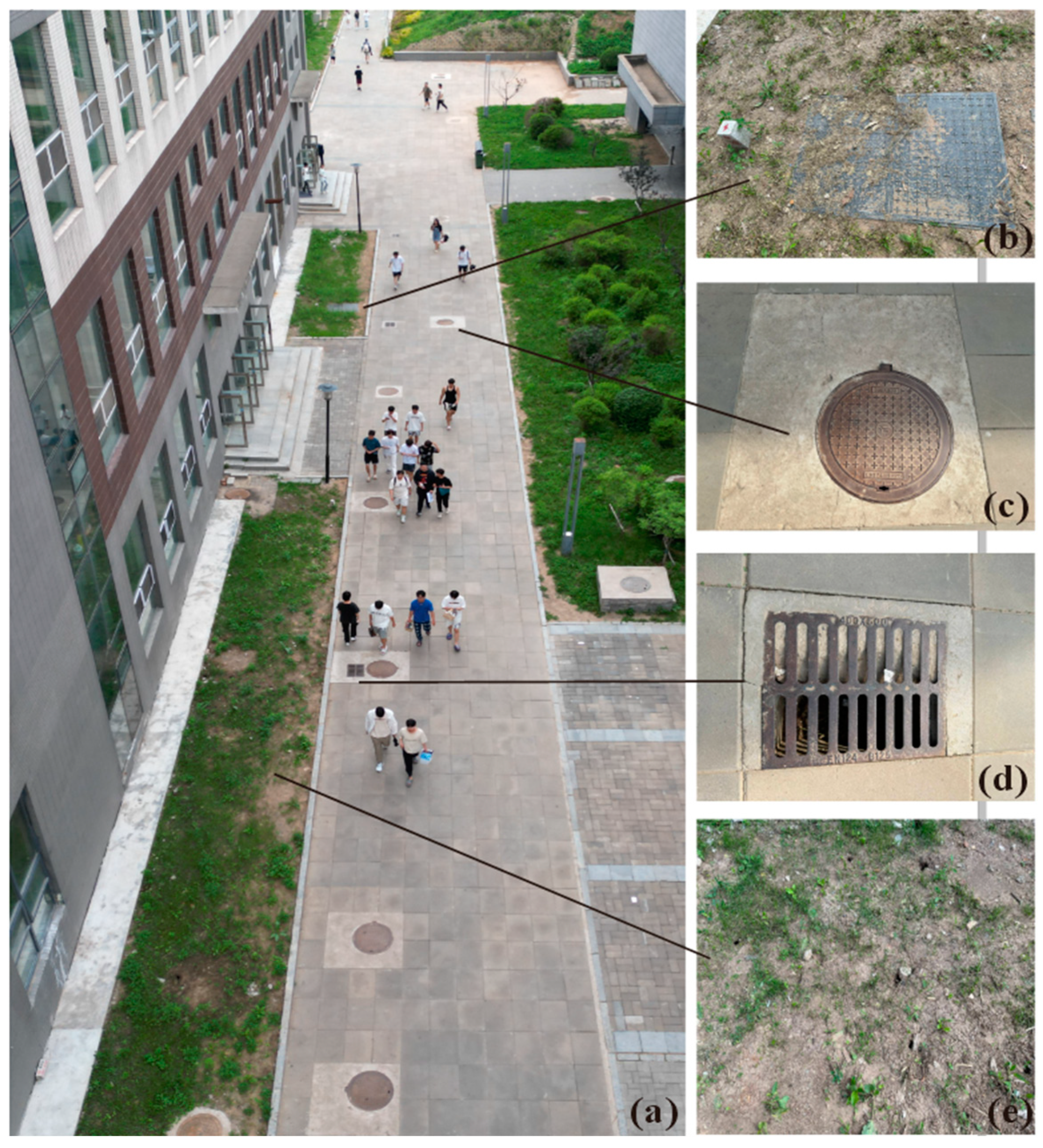

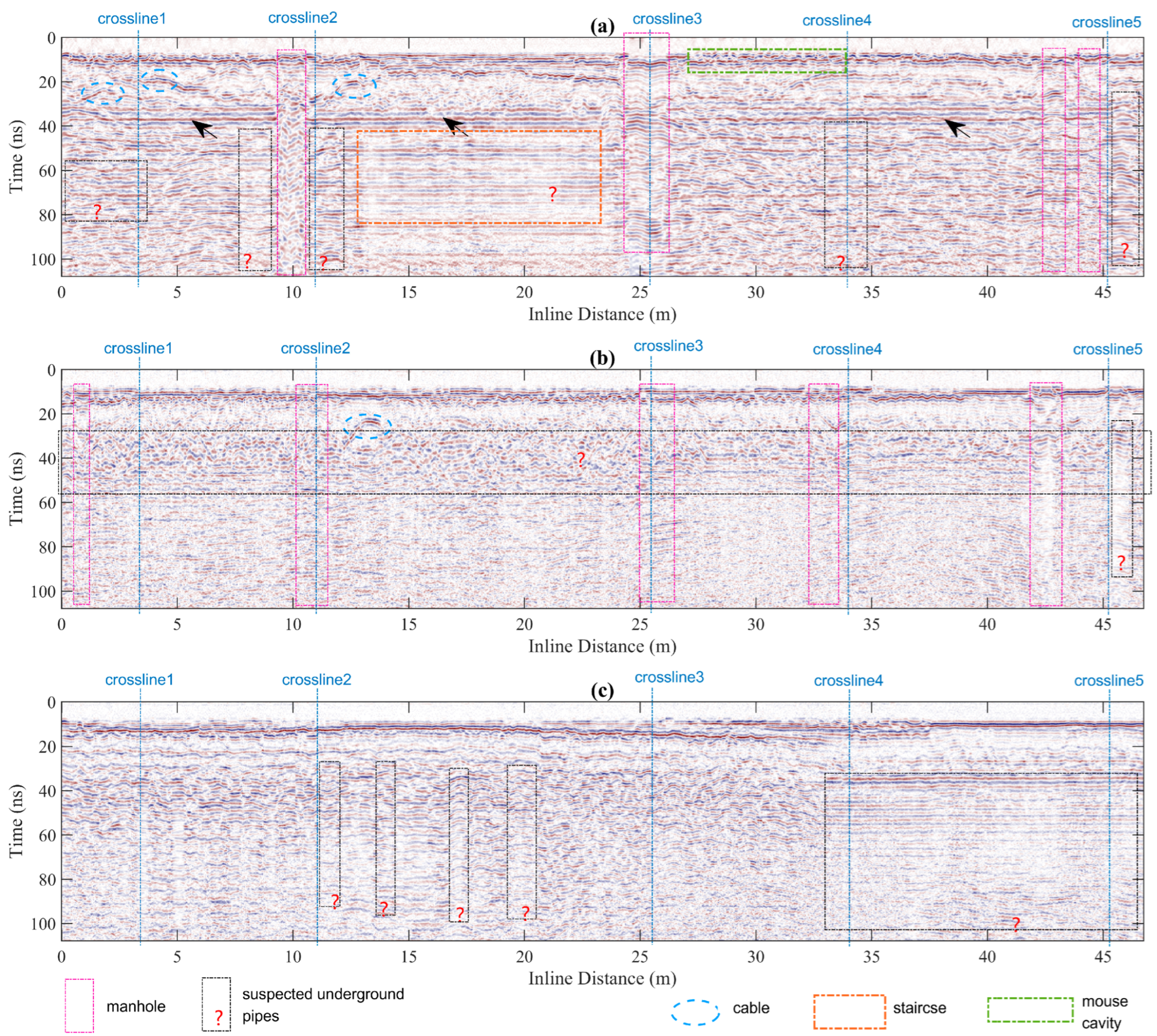
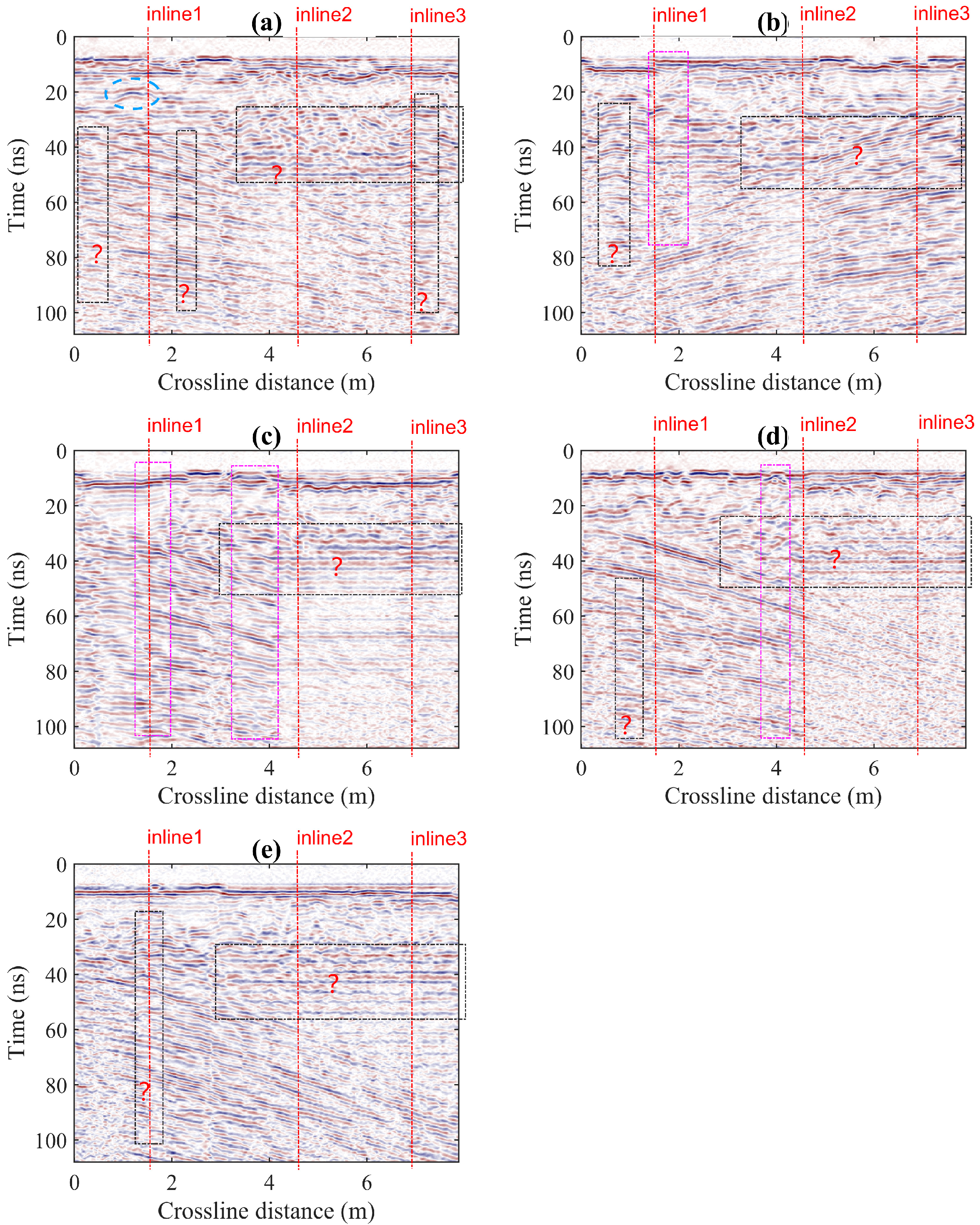
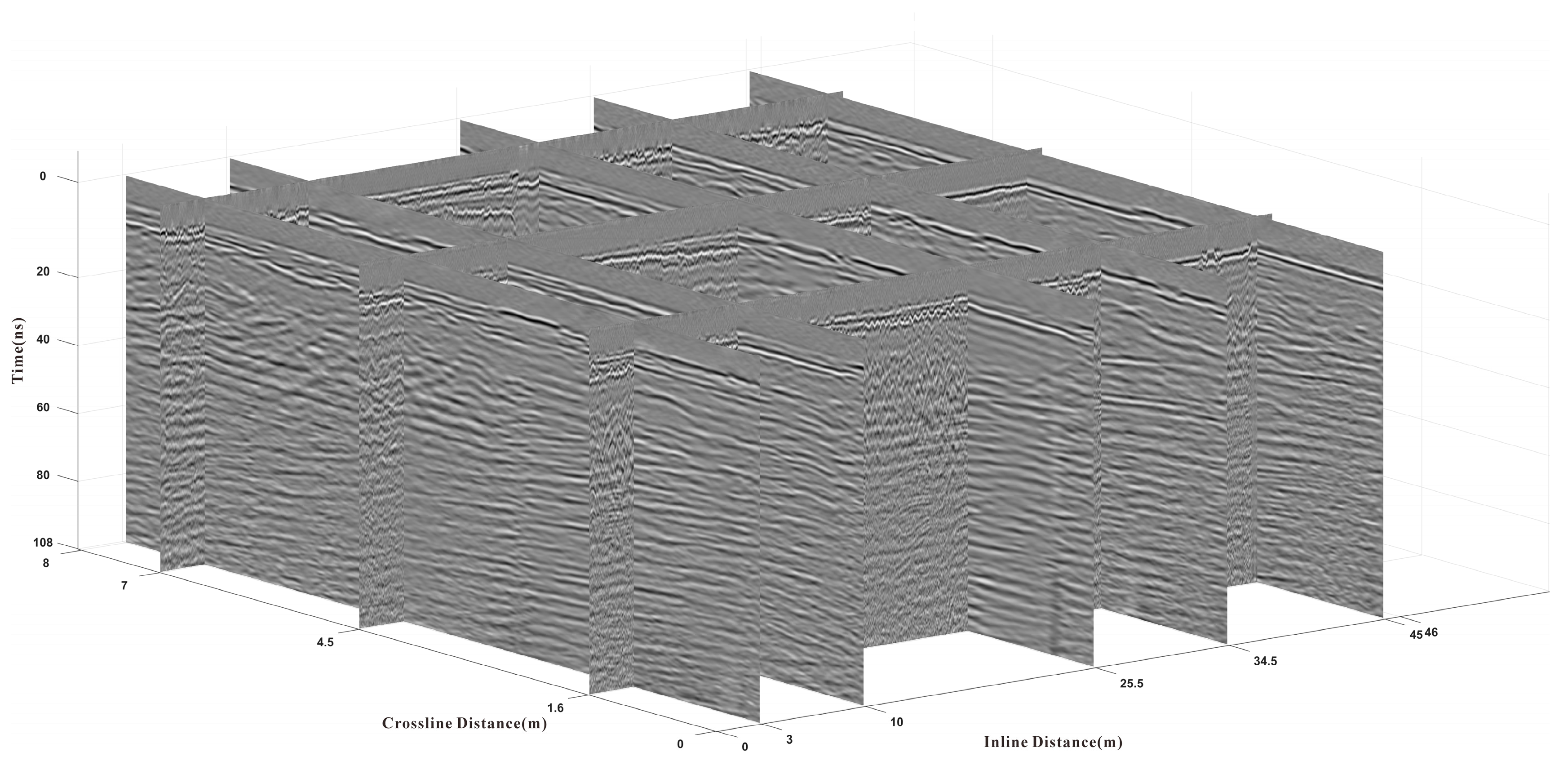

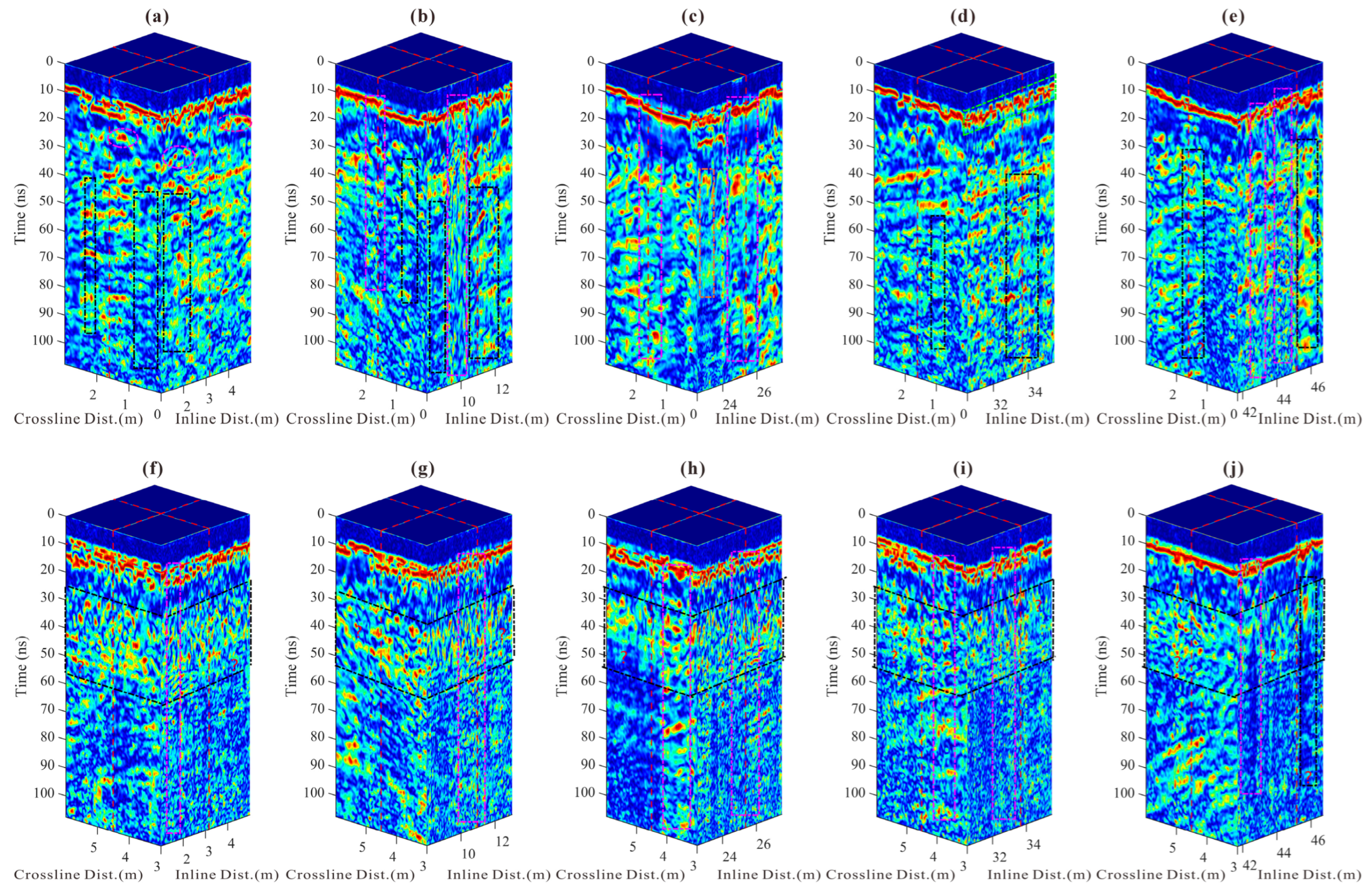

| Types of Underground Spaces | Form of Instantaneous Energy | Position in the Figure 8 |
|---|---|---|
| manholes | layered (with strong instantaneous energy) | rose dashed box in crossline slice in Figure 8b; rose dashed box inline slice in Figure 8c,e,h; |
| cluttered (with weak instantaneous energy) | rose dashed box in inline slice in Figure 8b,f–j | |
| underground spaces (suspected) | layered (with strong instantaneous energy) | black dashed box in crossline slice in Figure 8a,b,e; |
| cluttered (with weak instantaneous energy) | black dashed box in crossline slice in Figure 8d; black dashed box in inline slice in Figure 8c–e; black dashed box (25~55 ns) in both inline and crossline slices in Figure 8f–j; |
| Types of Underground Spaces | Presence of Instantaneous energy | Presence of Centroid Frequency | Marker Label |
|---|---|---|---|
| manholes | layered (with strong instantaneous energy) | minimal attenuation around the center frequency of 450 MHz | ③ |
| cluttered (with weak instantaneous energy) | noticeable reduction | ④ | |
| underground spaces (suspected) | layered (with strong instantaneous energy) | minimal attenuation around the center frequency of 450 MHz | ① |
| cluttered (with weak instantaneous energy) | noticeable reduction | ② |
Disclaimer/Publisher’s Note: The statements, opinions and data contained in all publications are solely those of the individual author(s) and contributor(s) and not of MDPI and/or the editor(s). MDPI and/or the editor(s) disclaim responsibility for any injury to people or property resulting from any ideas, methods, instructions or products referred to in the content. |
© 2024 by the authors. Licensee MDPI, Basel, Switzerland. This article is an open access article distributed under the terms and conditions of the Creative Commons Attribution (CC BY) license (https://creativecommons.org/licenses/by/4.0/).
Share and Cite
Zhang, X.; Pei, J.; Liu, H.; You, Q.; Zhang, H.; Yao, L.; Song, Z. Three-Dimensional Subsurface Pipe Network Survey and Target Identification Using Ground-Penetrating Radar: A Case Study at Jilin Jianzhu University Campus. Appl. Sci. 2024, 14, 7293. https://doi.org/10.3390/app14167293
Zhang X, Pei J, Liu H, You Q, Zhang H, Yao L, Song Z. Three-Dimensional Subsurface Pipe Network Survey and Target Identification Using Ground-Penetrating Radar: A Case Study at Jilin Jianzhu University Campus. Applied Sciences. 2024; 14(16):7293. https://doi.org/10.3390/app14167293
Chicago/Turabian StyleZhang, Xuebing, Junxuan Pei, Haotian Liu, Qin You, Hongfeng Zhang, Longxiang Yao, and Zhengchun Song. 2024. "Three-Dimensional Subsurface Pipe Network Survey and Target Identification Using Ground-Penetrating Radar: A Case Study at Jilin Jianzhu University Campus" Applied Sciences 14, no. 16: 7293. https://doi.org/10.3390/app14167293
APA StyleZhang, X., Pei, J., Liu, H., You, Q., Zhang, H., Yao, L., & Song, Z. (2024). Three-Dimensional Subsurface Pipe Network Survey and Target Identification Using Ground-Penetrating Radar: A Case Study at Jilin Jianzhu University Campus. Applied Sciences, 14(16), 7293. https://doi.org/10.3390/app14167293






